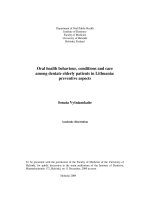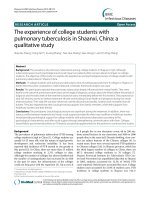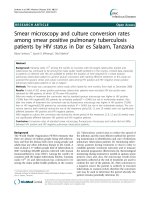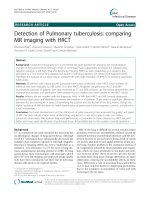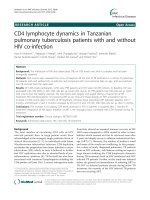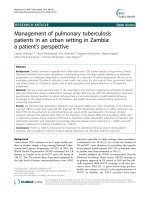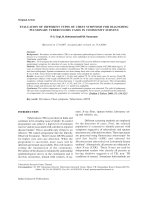Predictors of treatment failure among pulmonary tuberculosis patients in Mulago hospital, Uganda ppt
Bạn đang xem bản rút gọn của tài liệu. Xem và tải ngay bản đầy đủ của tài liệu tại đây (153.1 KB, 7 trang )
African Health Sciences Vol 11 Special Issue 1 August 2011
S105
*Corresponding author
Frederick Nelson Nakwagala
Department of Medicine
College of Health Sciences
Makerere University
Kampala, Uganda
Fax: 256-414-532591
Email:
Predictors of treatment failure among pulmonary tuberculosis
patients in Mulago hospital, Uganda
Namukwaya E
1
, *Nakwagala FN
1
, Mulekya F
2
, Mayanja-Kizza H
1
, Mugerwa R
1
1.Department of Medicine, College of Health Sciences, Makerere University Kampala, Uganda.
2. School of Public Health, Makerere University Kampala, Uganda.
Abstract
Introduction: Early identification of Tuberculosis (TB) treatment failure using cost effective means is urgently needed in
developing nations. The study set out to describe affordable predictors of TB treatment failure in an African setting.
Objective: To determine the predictors of treatment failure among patients with sputum smear positive pulmonary TB
at Mulago hospital. The study was carried out in the TB clinic of Mulago hospital Kampala, Uganda.
This was an unmatched case control study where fifty patients with a diagnosis of TB treatment failure (cases) and 100
patients declared cured after completing anti TB treatment (controls) were recruited into the study. Cases were compared
with controls to determine predictors of treatment failure.
Results: Significant predictors of treatment failure in this study included a positive sputum smear at 2 months of TB
treatment (OR 20.63, 95%CI 5.42- 78.41) and poor adherence to anti TB treatment (OR 14.59, 95%CI 3.04-70.15).
Conclusion: This study identified a treatment related and a simple laboratory predictor of TB treatment failure in Mulago
hospital which may be used in resource limited settings for early recognition of those at risk and early intervention.
Key words: Predictors; Treatment failure; Pulmonary TB
African Health Sciences 2011; 11(S1): S105 – S111
Introduction
The control of tuberculosis (TB) remains a challenge
globally,
1,2
more so in sub-Saharan Africa
2
and in high
burden countries like Uganda
where treatment target
goals have not yet been met.
2
For TB control, the
highest priority is to detect at least 70% of the
sputum smear positive cases and to cure at least 85%
of the sputum smear positive cases. If these targets
are achieved, there is a decrease in prevalence,
incidence, transmission and drug resistance to TB.
3
Treatment failure of TB, which is defined
as a patient who is sputum smear or sputum culture
positive at 5 months or later after the initiation of
anti TB treatment,
3
is one of the threats to the control
of TB. This is because of its association with Multi
Drug Resistant TB (MDR TB)
4
and also because
affected patients continue to spread TB. Patients with
treatment failure have a higher morbidity and
mortality compared to those who achieve cure.
5
The
World Health Organization (WHO) recommends
diagnosis of TB treatment failure in resource limited
settings by sputum smear microscopy at 5 months
or later during treatment.
3
However, identification
of those at risk of treatment failure is important
before the 5 months in reducing TB spread,
morbidity and mortality in affected individuals and
may help in contributing to the achievement of the
treatment targets. The ideal tool for this is frequent
laboratory monitoring using sputum microscopy or
culture. However, culture is not feasible in many
settings with limited laboratory” resources like most
of Uganda.
2
Given these constraints there is need to
obtain more easily measurable surrogate markers that
may serve as predictors of TB treatment failure.
Those patients identified to have the predictors of
TB treatment failure may be prioritized for the use
of limited laboratory resources. Studies done in other
settings show that these predictors include social,
radiological, laboratory and treatment related
factors.
4,6-20
No study had been done in our setting
to identify these predictors and we did a case control
study to identify them.
African Health Sciences Vol 11 Special Issue 1 August 2011S106
Methods
Ethical considerations
The study was approved by the Makerere University
Faculty of Medicine Research and Ethics Committee.
All participants gave written informed consent to
participate. Assent was obtained from those who
were under 18 years of age, in addition to the consent
of their parents or guardians.
Study site
The study was conducted between June and
December 2007 at Uganda’s main national referral
hospital of Mulago, in Kampala.
Study design and population
An unmatched retrospective case control study of
the predictors of treatment failure among patients
with sputum smear positive pulmonary TB was
conducted.
Eligible patients thirteen years and above,
with sputum smear positive TB at initiation of
treatment and a positive sputum smear at 5 months
or later after start of TB treatment were recruited.
Controls were patients who were thirteen years of
age and above, with sputum smear positive TB at
initiation of treatment and had a negative sputum
smear at 5 and 8 months after start of anti TB
treatment.
Poor adherence was used to calculate the
sample size since it is one of the most important
predictors of treatment failure from previous studies.
We used a level of poor adherence among treatment
failure patients of 40% and 15% among patients
who were cured.
21
Using the formula for comparison
of proportions a minimum sample size of 120
subjects (40 cases, 80 controls) would be needed to
achieve 80% power with a level of significance of
0.05
20
To increase the power of the study 50 cases
and 100 controls were recruited
Study procedure
Data abstraction was done from medical records,
patients’ charts, and clinic cards in addition to
interviewing patients. Those with incomplete records
were excluded. A radiologist reviewed archived
chest radiographs, which had been done at the time
of diagnosis of TB. All data were recorded on a
structured questionnaire. Information collected
included age, gender, marital status, highest education
level attained, approximate distance to the TB clinic,
alcohol or substance abuse, fever persisting after 2
weeks of TB treatment, weight loss despite treatment
or no weight gain, sputum smear microscopy results
at baseline, 2 months and 5 months or later during
treatment, drugs doses given and the presence of
other medical conditions including HIV and Diabetes
Mellitus (DM). All patients in this clinic were on the
same treatment regimen, which is 2 months of
rifampicin, isoniazid, ethambutol and pyrazinamide
followed by 6 months of ethambutol and isoniazid.
Predictors of treatment failure were defined
as factors which are associated with treatment failure
and may be used to identify those at risk of treatment
failure. These include socio-demographic, clinical,
laboratory, radiological, and treatment associated
factors.
Alcohol abuse was defined as a CAGE score of 2
and above
22
. Any weight gain or loss was calculated
by subtracting the patients’ weight at the start of TB
treatment, from the weight at the time the patient
was diagnosed with treatment failure or declared
cured.
Results of the HIV test were obtained from
the patients’ medical records. All patients in the TB
clinic are routinely counseled and tested for HIV.
Random blood sugar was tested using a Glucometer
(One Touch Ultra AW 060-368-13D Rev.03/2004,
lifescan Inc. Milpitas, California Unites States of
America). Diabetes Mellitus (DM) was defined as a
random blood sugar of 200mg/dl and above in
the presence of classic symptoms of
hyperglycaemia.
23
Persistent fever was defined as
fever lasting 2 or more weeks after initiation of anti
TB treatment while a high bacillary load was defined
as any sputum smear graded as having more than
10 acid alcohol fast bacilli per high power oil
immersion field or grade +++ in the laboratory.
Adherence was assessed by taking a
meticulous history to find out if patients missed any
treatment and by asking them to estimate the duration
of any treatment interruption. To minimize recall
bias, adherence to treatment was crosschecked using
the treatment card, which has space where patients
or their relatives check after taking medication. Poor
adherence was also assumed if the patients did not
return for a scheduled appointment within a week
of expected review on two or more occasions.
Extensive radiological involvement was defined as
lesion(s) involving an area of more than the
equivalent of one lung with or without cavities.
Data analysis
The data obtained was entered into Epi info 3.2.2
version, then exported to SPSS version 12.0 software
for analysis.
African Health Sciences Vol 11 Special Issue 1 August 2011
S107
Univariate analysis was performed to describe
the baseline characteristics of the participants while
bivariate analysis was performed to assess for
possible associations between the individual predictor
variables and the outcome predictor variable, which
was TB treatment failure. Binary logistic regression
using the backward elimination method was
performed to determine the predictor variables
while adjusting for confounding. The association
between TB treatment failure and independent
variables was assessed using odds ratios, 95%
confidence intervals and p values. A p value of 0.05
or less was considered significant. The Chi-square
tests were computed and the Fisher’s exact test was
used for cell frequencies less than five.
Results
Of the 1950 TB patients seen between June and
December 2007, 873 had smear positive pulmonary
TB while 1087 had either smear negative or extra
pulmonary TB. For enrolment into the study, we
considered the 170 of the smear positives who were
at 5
th
, 6
th
, 7th, or 8
th
month of treatment. This
yielded 60 smear positive patients after 5 months of
treatment. Out of these, 50 were finally recruited as
cases excluding 2 for consent related reasons and 8
for inadequate records. Out of the 170 smear
positives we also considered 110 who had turned
smear negative after five months as controls. We
excluded ten for inadequacy of case records and
finally recruited 100 controls as shown in figure 1.
Figure 1: Illustration of the study profile
Baseline characteristics
Baseline characteristics were comparable for cases
and controls except distance from the clinic, with
treatment failure cases significantly more likely to live
further from the clinic than the controls (p= 0.0030,
CI 1.07-4.34) as shown in Table 1.
African Health Sciences Vol 11 Special Issue 1 August 2011S108
Table 1: Baseline characteristics among cases and controls
Risk factors associated with treatment failure
Cases (treatment Variable Controls (cured) Unadjusted P value 95% CI
failure N=100 % OR
N=50 % Age
25 50 <32 years 58 58 0.72 0.330 0.37-1.43
25 50 >32 years 42 42 1.00
Gender
33 66 Male 59 59 1.35 0.407 0.67-2.73
17 34 Female 41 41 1.00
Education level
27 54 None or primary 47 47 1.32 0.419 0.67-2.62
23 46 Secondary or 53 53 1.00
tertiary
Marital status
26 52 Not married 65 65 0.58 0.124 0.29-1.16
24 48 Married 35 35 1.00
Alcohol abuse
3 6 Yes 3 3 2.06 0.401 0.40-10.61
47 94 No 97 97 1.00
Distance to clinic
24 48 >5km 30 30 2.15 0.030 1.07-4.34
26 52
<5km 70 70 1.00
Using bivariate analysis treatment failure cases were
significantly more likely to have: persistent fever
(p<0.0001), weight loss (p<0.0001), missed doses
of treatment (p= 0.002), missed clinic appointments
(p<0.0001), cavities on the baseline chest radiograph
(p< 0.0001), extensive disease on the baseline chest
radiograph (p= 0.038), a higher bacillary load at
baseline (p< 0.0001) and positive sputum smear at 2
months of TB treatment (p<0.0001) as shown in
table 2.
Table 2: The association between the different factors and treatment failure on bivariate analysis
Variable Cases (treatment Controls (cured) Unadjusted P value 95% CI
failure) OR
N=50 % N=100 %
HIV positive 21 42 50 50 0.72 0.355 0.37-1.44
Presence of DMBS
>200mg/dl 2 4 0 0 * 0.050 *
Persistent fever 22 44 0 0 * <0.0001 *
Weight loss 22 44 13 13 5.26 <0.0001 2.35-11.79
Distance to clinic > 5km 24 48 30 30 2.15 0.030 1.07-4.34
Missed doses> 2 weeks 21 42 18 18 3.30 0.002 1.55-7.05
Missed clinic appointments 22 44 6 6 12.31 <0.0001 4.55-33.34
Adverse effects of drugs 16 32 34 34 0.91 0.806 0.44-1.88
Insufficient dose for weight 4 8 4 4 2.09 0.304 0.50-8.72
Cavities on CXR at baseline 36 72 40 40 3.86 <0.0001 1.84-8.05
Extensive disease on CXR 32 64 46 46 2.09 0.038 1.04-4.19
High bacillary load at baseline 37 74 40 40 4.27 <0.0001 2.02-9.01
(+++)
Positive sputum smear at 36 72 6 6 40.29 <0.0001 14.37-112.92
2 months
*Not calculated as one of the cells had zero so could not be cross-tabulated or computed
+++ = more than 10 acid alcohol fast bacilli per high power oil immersion field, CXR= chest radiograph
African Health Sciences Vol 11 Special Issue 1 August 2011
S109
Binary logistic regression using the backward
elimination method was done to control for
confounding. All the factors that were statistically
significant during bivariate analysis, plus potential
confounders, were entered into a model for
multivariate analysis. Predictors of treatment failure
by multivariate analysis included a positive sputum
smear at 2 months of TB treatment (OR 20.63,
95%CI 5.42- 78.41) and poor adherence to anti TB
treatment (OR 14.59, 95%CI 3.04-70.15) as shown
in Table 3.
Table 3: Association between the different factors and treatment failure on multivariate analysis
Variable Unadjusted OR 95% CI P value Adjusted OR 95% CI P value
Positive sputum smear 40.27 14.37-112.91 <0.0001 20.63 5.42-78.41 <0.0001
at 2 months
Missed clinic 12.31 4.55-33.34 <0.0001 14.59 3.04-70.15 0.001
appointments
Cavities on CXR at 3.86 1.84-8.05 <0.0001 3.02 0.84-10.80 0.090
baseline
Distance to clinic 2.15 1.07-4.34 0.030 2.26 0.63-8.03 0.210
> 5km
Fever> 2weeks * * <0.0001 * * 0.998
Sputum smear at 4.27 2.02-9.01 <0.0001 0.48 0.11-2.18 0.34
baseline
Presence of DMBSe * * 0.050 1.00 * *
>200mg/dl
Weight loss 5.26 2.35-11.79 <0.0001 1.135 0.15-8.68 0.99
Missed doses 3.30 1.55-7.05 0.002 0.67 0.16-16.67 1.64
Extensive disease on 2.09 1.04-4.19 0.038 0.77 0.29-5.13 1.23
CXR
+++ = more than 10 acid alcohol fast bacilli per high power oil immersion field,
CXR = chest radiograph, DM= diabetes mellitus, BS= blood sugar
*Not calculated due to small numbers in some cells
Discussion
This study examined socio-demographic, clinical,
radiological, laboratory and treatment related factors
associated with treatment failure in the TB clinic in
Mulago hospital, Kampala. We found that a positive
sputum smear at 2 months of anti TB treatment
and poor adherence to anti TB treatment were
predictors of treatment failure. None of the socio-
demographic factors was associated with TB
treatment failure in our study. Living further from
the TB clinic had earlier been found to be associated
with treatment failure by Shargie et al in 2007 in
Ethiopia (HR 2.97, p<0.001)
24
. This may be due to
failure to return for drug refills because of the longer
distance, leading to poor adherence. In our setting
the effects of this factor could have been masked
by presence of various TB clinics within the city.
Our study did not find alcohol abuse, lower level
of education and male gender to be risk factors for
TB treatment failure contrary to studies elsewhere
7,
8
.
There may be other socio-cultural characteristics
among our population that blunted any differences.
Clinical factors previously described by other authors
as risk factors for TB treatment failure including
Diabetes Mellitus
8
, persistent fever
9
, weight loss
10,11
and HIV
12
seropositivity were not significant in our
study.
A positive sputum smear at 2 months of TB
treatment was found to be the strongest predictor
of treatment failure in our study. This is in agreement
with Chavez et al’s finding in Peru (OR 1.7, p=0.008)
6
.
This is an important observation since sputum
microscopy is a low cost investigation and that can
be used by TB programs to identify those at risk for
early intervention. The first 2 months of TB treatment
is when there is rapid killing of actively dividing bacilli
and the semi-dormant bacilli. The majority of
sputum smear positive patients turn negative within
this period
3
.
It is possible that a positive sputum
smear at 2 months is due to primary drug resistance
or alternatively, selection of mutant strains leading
to MDR TB and treatment failure especially in the
context of poor adherence
25
. This emphasizes the
recommendation by TB programs to prolong the
intensive phase if the sputum smear is positive at 2
African Health Sciences Vol 11 Special Issue 1 August 2011S110
months
3
.
A high bacillary load at baseline was not
associated with treatment failure in this study contrary
to findings by Singla et al (p<0.001).
13
These
differences could be accounted for by the higher
rate of default on treatment among those who had
a higher bacillary load and the intermittent regimen
used in Singla’s study.
13
It is noteworthy that Keane
et al who used a treatment regimen similar to ours
did not find high bacillary load at start of treatment
a predictor of treatment failure.
11
Presence of cavities
on the chest radiograph and extensive radiological
involvement were not found to be significantly
associated with treatment failure at multivariate
analysis contrary to what was demonstrated by Qing-
song et al (OR 1.5, p=<0.001)
14
This was probably
due to inadequate sample size. Poor adherence to
treatment was also a predictor of treatment failure
in our study. This is in agreement with findings of
Morsy et al
8
(OR 1.4, p<0.05), Burman et al
15
(RR
9.9, p<0.001) and Diel et al
16
(p<0.001). Poor
adherence leads to development of drug resistance
which may explain the treatment failure. Given these
findings, program interventions like Directly
Observed Therapy short course (DOTS), which
enhance adherence, should be emphasized.
Conclusion
Positive sputum smear at 2 months of TB treatment
and poor adherence to anti TB treatment were found
to be predictors of TB treatment failure in Mulago
Hospital. These factors may be used in resource
limited settings for early recognition of those at risk
and early intervention.
Recommendations
The National TB programs should emphasize the
recommendation of sputum microscopy at 2
months of treatment to detect those at risk so that
they can be followed up closely. Patients with poor
adherence to treatment should be closely followed
up to prevent treatment failure. Studies need to be
done to find out the effect of prolonging the
intensive phase of treatment in those with positive
sputum smears at 2 months.
Limitations of the study
Culture and sensitivity of TB was not done for
controls so it was difficult to tell if drug resistance
was a predictor of treatment failure.
Some patients were excluded because they were
missing important data in their records. This may
have introduced bias if having missing records is
related to certain risk factors.
The definition of treatment failure used was the one
recommended by WHO for resource limited settings
and therefore sputum culture was not used in the
definition, which could have led to misclassification
of cases and controls. Serum drug levels to quantify
adherence were not feasible in our study. The sample
size was inadequate as shown by the wide confidence
intervals and therefore some predictors with lower
odds ratios could have been missed.
Acknowledgements
We acknowledge the research assistants, members
of the department of medicine and other
departments, the staff of the TB clinic especially,
the Forgarty Ellison foundation and Dr. C Whalen
for the initial guidance and facilitation in this research.
References
1. World Health Organization (WHO) fact sheet
No 104. Revised March 2007:1-3. http://
www.who.int/mediacentre/factsheets/fs104/
en/. last accessed on 5/050/09.
2. Profiles of High burden countries. WHO Report
2007, Global Tuberculosis control, surveillance,
planning, financing. Annex 1:145-148. http://
www.who.int/tb/publications/global_report/
2009/pdf/chat1.pdf. Last accessed
3. Harries A, Maher D and Graham S.
Management of patients with tuberculosis. In:
TB/HIV a clinical manual, Geneva: World
Health Organisation. p.111-115.
4. Becerra MC, Freeman J, Bayona J, et al. Using
treatment failure under effective directly
observed short course chemotherapy
programme to identify patients with Multi drug
resistant tuberculosis. Int J Tuberc Lung Dis. 2000;
4:108-114.
5. Sadacharam K, Gopi P, Chandrasekaran S, et al.
Status of smear TB patients at 2-3 years after
initiation of treatment under a DOTS
programme. Ind J Tuberc. 2007; 54:199-203.
6. Chavez Pachas AM, Blank R, Smith Fawzi MC,
Bayona J, Becerra MC and Mitnick CD.
Identifying early treatment failure on category I
therapy for pulmonary tuberculosis in Lima
Ciudad, Peru. Int J Tuberc Lung Dis. 2004; 8:52-
58.
7. de Albuquerque M de F, Ximenes RA, Lucena S
et al. Factors associated with treatment failure,
drop out, and death in a cohort of tuberculosis
African Health Sciences Vol 11 Special Issue 1 August 2011
S111
patients in Recife, Pernamubuco State,Brazil. Cad
Saude Publica.2007; 23:1573-1582.
8. Morsy AM, Zaher HH, Hassan MH and
Shouman A. Predictors of treatment failure
among tuberculosis. Patients under DOTS
strategy in Egypt. East Mediterr Health J. 2003;
9:689-701.
9. Kiblawi SS, Jay SJ, Stonehill RB, et al. Fever
response of patients on therapy for pulmonary
tuberculosis. Am Rev Respir Dis.1981; 123: 20 –
24.
10. Rossana A, Ditangco, Melchor C, et al. Clinical
predictors of response to tuberculosi
chemotherapy. Philippine Journal of Microbiology and
Infectious Diseases. 1996;25:1820.
11. Keane VP, de Klerk N, Krieng T, Hammond G
and Musk WA. Risk factors for the development
of non-response to first line treatment for
tuberculosis in Southern Vietnam. Int J
Epidemiol.1997; 26:1115-1120.
12. Perriens JH, Colebunders RL, Karahunga C, et
al. Increased mortality and tuberculosis treatment
failure rate among HIV seropositive compared
with HIV sero-negative patients with pulmonary
tuberculosis treated with ‘standard’
chemotherapy in Kinshasa, Zaire. Am Rev Respir
Dis.1991; 144:750-755.
13. Singla R, Singla N, Sarin R and Arora V.K.
Influence of pre-treatment bacillary load on
treatment outcome of Pulmonary Tuberculosis
patients receiving DOTS under revised National
Tuberculosis Control Programme. Ind J Chest Dis
Allied Sci. 2005; 47:1923.
14. Qing-Song Bao, Yu-Hua Du, Ci-Yong Lu.
Treatment outcome of new pulmonary
tuberculosis in Guangzhou, China, 1993-2002:
a register–based cohort study. BMC Public Health.
2007; 7:344.
15. Burman WJ, Cohn DL, Reitmeijer CA, Judson
FN, Sbarbaro J A and Reves RR. Non ompliance
with directly observed therapy for tuberculosis.
Epidemiology and effect on the outcome of
treatment. Chest. 1997; 111:1168-1173.
16. Diel R, Niemann S. Outcome of tuberculosis
treatment in Hamburg: a survey,1997 2001. Int
J Tuberc Lung Dis.2003; 7:124-131.
17. Jindani A, Nunn A, Earson D. Two-8month
regimens of chemotherapy for treatment of
newly diagnosed pulmonary tuberculosis. Lancet.
2004;364:1244-1251.
18. Jindal SK. Antituberculosis treatment failure in
clinical practice. Ind J Tub.1997; 44: 121-124.19.
19. Manmoudi A, Iseman M. Pitfalls in the care of
patients with Tuberculosis. Common errors and
their association with the acquisition of drug
resistance. JAMA.1993; 270:65-68.
20. Stephen Hulley, Steven Cummings, Warren
Browner Designing Clinical Research Lipincott
Williamsssss and Wilkins Second Edition
Chapter 6 page 87 ISBN 0781722187.
21. Johnson JL, Okwera A, Vjecha MJ, et al. Risk
factors for relapse in Human Immunodeficiency
virus type 1 infected adults with pulmonary
tuberculosis. Int J Tuberc lung Dis.1997 Oct;
115:446-453.
22. Marc Ghany, Jay h. Hoofnagle Approach to the
Patient with Liver Disease in Harrisons Principles
and Practice of Medicine. The McGraw-Hill
Companies, Inc. 2005 Edition page 1808-1822
23. Alberti KG, Aschner PA, Assal J P, et al.
Definition, diagnosis and classification of
Diabetes Mellitus and its complications. Report
of a World Health Organization (WHO)
consultation, WHO, 1999. Downloaded at http:/
/www.staff.ncl.ac.uk/philip.home/
who_dmc.htm on 02/02/09 .
24. Shargie E, Lindtjorn B. Determinants of
Treatment Adherence among Smear-Positive
Pulmonary tuberculosis patients in Southern
Ethiopia. PLoS Med.2007; 4:e37
25. Mitchison DA. How drug resistance emerges as
a result of poor compliance during short course
chemotherapy for tuberculosis. Int J Tuberc Lung
Dis. 2002; 2:10-15.
